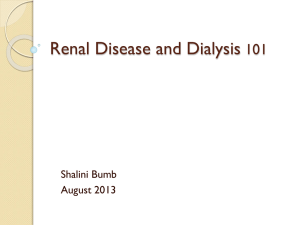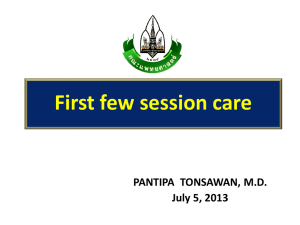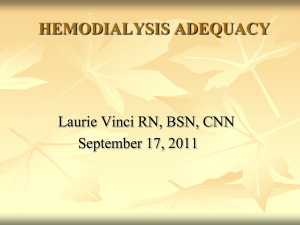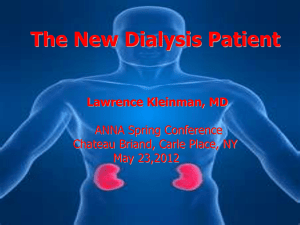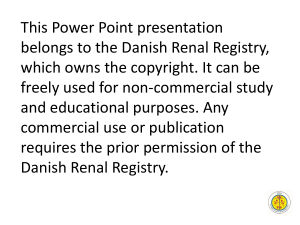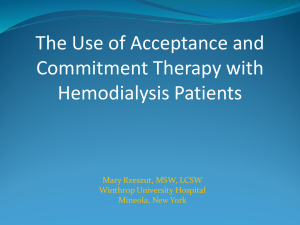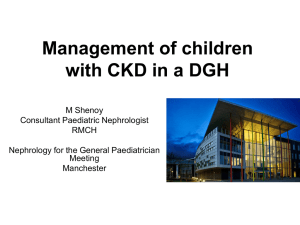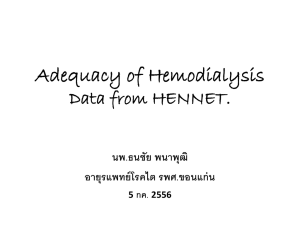Hemodialysis in Children - Saudi Society of Nephrology
advertisement
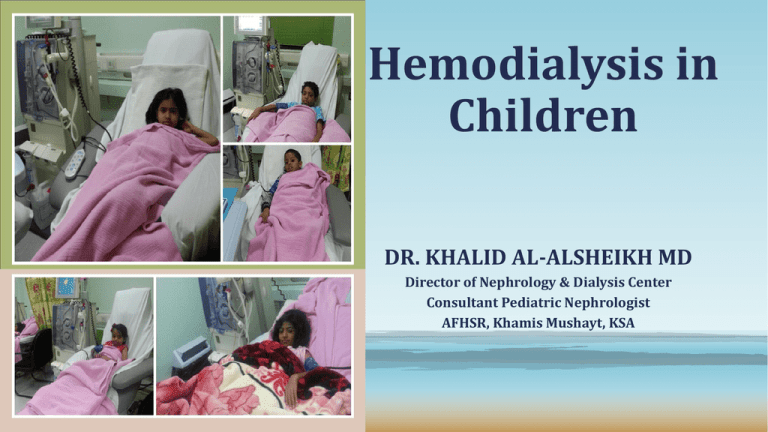
Hemodialysis in Children DR. KHALID AL-ALSHEIKH MD Director of Nephrology & Dialysis Center Consultant Pediatric Nephrologist AFHSR, Khamis Mushayt, KSA Introduction • In children with chronic kidney disease as GFR declines to less 30ml/min/1.73 m2 ( Stage 4 CKD) • Preparation for renal replacement therapy are needed. • The child and his family should be provided with information related to preemptive kidney transplantation • Peritoneal dialysis • Hemodialysis • Renal replacement therapy is initiated in children with CKD stage 5 in some children with CKD stage 4 • Hemodialysis in children progress over last 20 years • Morbidity of the session has decreased • Technological progress, the availability of ESA and GH enhanced dialysis dose and increase quality of life • Technically all children can underwent HD even infants 2 Indication of RRT • Renal function, ?GFR • Before uremic symptoms • Fluid status • Biochemical abnormalities • Acute renal failure • Oligoanuric • Resistant volume overload to medical treatment • Hyperkalamia resistant to medical treatment • Persistent metabolic acidosis resistant to medical treatment • Uremic encephalopathy • Uremic pericarditis • Inborn error of metabolism • Intoxication 3 Incidence of ESRD in Children • ESRD in children is uncommon • Incidence in USA 14.8 / Million New Zealand 13.6 / million Japan 4 / million • The choice of RRT children: • ¼ underwent preemptive renal transplantation • ½ started in peritoneal dialysis • ¼ started in hemodialysis • Preemptive kidney transplantation which is performed prior to the need of dialysis. • Renal transplantation is associated with better quality of life (Growth and Development) 4 Pediatric Dialysis in Saudi Arabia • HD Patients above 75 years and below 15 years of age 2012 • Below 15 years 223 (1.8%) • 15-75 11739 (91.4%) • Above 75 878 (6.8%) • PD patients adult and children 2012 • Children 172/1327 = 13% • Adults 1155/1327 = 87% SCOT Annual Report 2012 5 Epidemiology of chronic kidney disease in children Pediatr Nephrol (2012) 27:363–373وJérôme Harambat & Karlijn J. van Stralen &Jon Jin Kim & E. Jane Tizard 6 Chronic Renal failure in children in Asir Region of Saudi Arabia N. Alharbi Saudi Journal of Kidney Disease and Transplantation 1997 V8 Issue 3 pp 294-297 7 Chronic Renal failure in children in Western Area of Saudi Arabia Jameela A. Kari Saudi Journal of Kidney Disease and Transplantation year 2006 V17 Issue I pp 19-24 8 9 Comparison of RRT Modalities in Children 10 Choices of Dialysis • When preemptive transplantation is not an option • the choices between the two forms of dialysis is generally dictated by patients age, technical, social, compliance issues and family preference. 11 12 Principle of Vascular Access • Deliver adequate flow rate • Has long use life • Has low rate of complications • - Infection • - Stenosis • - Thrombosis • - Aneurysm • - Limb ischemia 13 • The best is AVF • USA - CVC used most often more than AVF and graft - CVC 89% For children<13 Years 64% 13-19 YEARS • Review of 2006 annual reports (NAPRTCS) reveals that in a family of pediatric patients 78.9% receiving HD have CVC as primary access. • AVF 12.3% • AVG 8.5% 14 AV Fistula con’t. • PREFERRED SITE FOR AVF IN CHILDREN 1.Radiocephalic 2.Brachiocephalic 3.Brachiobasilic with or without transposition • Alternative: - Ulnar artery to basilic vein - Femoral artery to saphenous vein - Nondominant forearm 15 Definite guidelines regarding minimal vessel sites don’t exist • General consensus preferred of minimum 2.5 mm venous diameter • Doppler U/S scanning or venography can provide information regarding adequate: A) vessel size B) venous stenosis 16 AVG AVG Should be considered an option for HD access in children especially who require replacement of native vessels to perform an adequate anastamosis Alternative materials: 1.Saphenous vein 2.Bovine 3.Umbilical 4.Darcon 5.Polyurethane, cryopreserved femoral vein 6.Polytetrafluorethylene (PTFE) is most commonly used 17 • One study compare bovine with PTFE graft demonstrated fewer complications with PTFE ones: • - Lower infections • - Lower thrombosis • - Easier to obtain and easier to repair • Graft are most commonly placed in forearm between brachial artery & basilic to brachial vein. • The thigh can be used femoral artery and saphenous to femoral vein in small children • -Higher infection rates been noted with thigh graft than with upper extremity grafts 18 • Advantage of AVG 1.Shorter time to use 2.High primary potency rate 3.Ease of technical creation • Sheath et al reported creation of 24 AVF and 28 AVG respectively . • The most common site of AVG is the thigh -50% of patients • Disadvantages of AVG 1.Thrombosis 2.Stenosis 3.Infection Sheath et al permanent vascular access survival in children and adolescent with end stage renal disease 2002 Kidney Int 62:1864-1869 19 • Ramage et al reported long term complications rate of AVF compare with AVG in retrospective study conducted over 20 years - Intervention rate 17.8% AVF compared to 33% of AVG Reason of discontinuation of AVG were: 1. Infection 20% 2. Thrombosis 73% • Chant et al evaluated dialysis adequacy , KT/V , URR, anemia management and albumin status based on vascular access. No difference between AVF & AVG • Possible Complications of graft 1. Thrombosis 2. Stenosis 3. Infection 4.Steal syndrome Ramage et al Vascular access survival in children and young adults receiving long term hemodilaysis 2005 AJKD 45:708-714 Chant et al Comparison of vascular access type for pediatric HD with respect to urea clearance, anemia management, & serum albumin conc. 2005 AJKD 45:303-308 20 COMPARISON BETWEEN AVF & AVG AVF AVG Lower infection Higher infection Lower thrombosis rate Higher thrombosis rate May take 3-6 months to mature Can be use within few weeks Primary Failure rate is higher Primary Failure is lower Secondary Failure rate is lower Secondary Failure rate is higher 21 CENTRAL VENOUS CATHETER • Central venous catheter are the most commonly used vascular access in children in north America data from USRDS 40% of children who were receiving chronic HD continued to use catheter • Data from ANZDATA 2008 showed the catheters were used exclusively below 10 years of age • NAPRTCS 2008 • 78% catheters • 12% AVF • 7% AVG • European Pediatric Dialysis Working Group • 60% catheters • 38% AVF • 2%AVG 22 CENTRAL VENOUS CATHETER First choice in patient require urgent HD 2. Stage V CKD 3. As abridge from a patient who is expected to receive planned transplant 4. Is training to transfer to PD - Advantage - It can be used immediately - Disadvantage 1. Short life span 2. Thrombosis 3.Infection 4. Malfunction 5. Possible fibrin sheath formation - Median survival times of CVC is 4 months – 10.6 months 23 CENTRAL VENOUS CATHETER • Goldstein et al evaluated catheter survival time in 58 uncuffed & 22 cuffed CVCs • Median survival time of uncuffed catheter is 31 days and cuffed catheter is 123 days • 1 year survival of long term cuffed catheter 27% • CVC in children whose vasculature is too small <10 kg, CVC may be the best temporary solution • Goldstein et al 1997 HD catheter survival and complications in children and adolescent pediatric nephrology 11: 74-77 24 • Two questions to be answered: • What size of catheter to use? • Where to put it? 25 “SIZE MATTERS!” • Pousielle’s law- Q = ∆Pπr4 8l • Smaller diameters offer greater resistance to flow • Longer lengths offer greater resistance to flow • Decreasing the diameter by 1/5th is the same as doubling the length (roughly a 2 French size difference) 27 Catheter Specifications French Size 5 7 8 10 12 Flow Rate (ml/min) ? 80-100 150-200 250-300 285-330 28 Catheter Specifications French Size 5 7 8 10 12 Diameter (mm) 1.67 2.3 2.7 3.3 4.0 29 Vascular Access • Central Venous catheter • Cuffed catheter • Uncuffed catheter type Weight size Uncuffed catheter dual lumen Up to 20 8 20-30 10 Above 30 11.5 20-40 7 40-60 10 Above 60 12 20-40 10 Tesio Catheter Ash Split 30 Complications of CVC • USRDS data have shown sepsis rate with CVCs approximate 80/100 patient as compared to 10/100 patient for AVF • Potential sequences of CVC include: - Septic shock - Subacute bacterial endocarditis - Osteomyelitis - Epidural abscess • One study evaluated potential differences in infection rate based on use of three agents for exit site care - 2% chlorhexidine found infection rate is 0.5% - 10% povidine iodine found infection rate is 2.5% - 70% alcohol found infection rate is 2.3% • Different antimicrobial catheter lock studies suggest that citrate is ideal 31 PROS AND CONS OF CENTRAL VENOUS CATHETER FOR HD IN CHILDREN PROS CONS Easily placed Infection rate high Can be use immediately Failure rate and replacement rate high Painless to the patient Blood flow rates are variable Require little planning prior to placement Permanent damage to central venous system (stenosis/thrombosis) Easily removed if used as transitional access for future PD on transplant patients Damage to central vessels can prohibit future AVF/AVG placement in ipsilateral extremity No vascular Steal Possible arrythmia Decreased risk of high outpatient cardiac failure 32 Monitoring of vascular access • Goldstein et al described use of dilution technique on regular basis on pediatric patient population to date improve the life of access. • Use of ultrasound 50% reduction in number of hospitalized patient. • This further supported by NFK/K-DOQI guidelines for pediatric vascular access . • Based on review of current literature the authors would propose the following as tools for ongoing monitoring of AVFs and AVGs. 33 Access Monitoring • 1. Inspection: the access should be assessed weekly through inspection, palpation, and auscultation by the nursing staff. • - With specific attention to arm swelling. • - Prolonged bleeding after needle removal. • - Change in thrills or bruits. • -The nephrologist should inspect the access at each physical examination. • 2. Surveillance ↓KT/V or URR. Determination of access recirculation should be documented on a monthly basis. • Ultrasound dilution/month if not available do Doppler U/S /month. 34 Access Monitoring • 3. Referral: Fistulogram with possible angioplasty if: - Inadequate blood flow comprising adequacy. - Elevate access recirculation >20% after needle connection. - Corrected access flow less than 650ml/min/1.73m2 by U/S dilution. - Consistent abnormality on Doppler U/S. -Pseudoaneurysm has formed, rotation of puncture site can help minimize risk of pseudoaneurysm. 35 Hemodialysis Prescription • Hemodialysis Equipment: • Tubing • Dialyzer • Dialysis Machine • Tubing: Tubing Pt. weight Venous (ml) Arterial (ml) Total Mini Neonatal <6 kg 21 8 29 Neonatal 6-12 kg 22 18 40 Pediatric >12 kg 42 30 72 Adult >30 kg 70 60 132 36 Types of Dialyzer • Dialyzer: • Types of Membrane • Blood volume capacity • Service area • UF coefficient • Clearance of various substances • Sterilization 37 Hemodialysis Prescription • Types of Dialyzer • Low flux (KUF <10 ml/hr/mmHg) • High flux KUF 15-60 ml/mmHg • Hallow fiber (capillary) • Parallel Plate • Types of Membranes • Unmodified cellulose low flux • Modified cellulose (Low & high flux) • Synthetic (low & high flux) • Synthetic noncellulose membranes are more biocompatible, size of dialyzer shouldn’t exceed 75-100% of patient service area 38 Selection of Dialyzer that can be used in children UF Coefficient (ml/min/mmHg) Fill Volume (ml) Surface Area (m2) Dialyzer 9.5 77 1.3 Gambro 12.5 103 1.7 Polyflux 17L 53 81 1.1 Polyflux 11S 62 102 1.4 Polyflux 14S 71 121 1.7 Polyflux 17S 15 17 0.2 2H (HF) 33 52 0.6 6H (HF) 1.7 28 0.4 4.3 42 0.7 F4 HPS 6.2 63 1.0 F5 HPS 8.5 82 1.3 F6 HPS 9.8 102 1.6 F7 HPS 11.1 114 1.8 F8 HPS 49 69 1.1 62 78 1.3 130 (HF) 63 91 1.5 150(HF) 80 126 2.1 210(HF) 2.5 35 0.5 8.1 65 1.1 Fresenius Xenium Baxter Polyflux 14L F3 110 (HF) CA-50 (LF) FB 110GA 39 Hemodialysis Prescription con’t. • Dialysis Machine: • Precise control of UF, volumetric assessment • Capable of low blood flow speeds • Ability to use lines of varying blood volume • Measure removal of very small amount of fluids • Continuous blood volume monitoring 40 Hemodialysis Prescription • Blood Flow rate • 1st session 90 ml/m2 2-3 ml/kg/min • Latter 5-7 ml/kg/min 150-200 ml/m2 • Dialysate: It compose • Treated water • Electrolytes Na 140 mmol/L, K 2-3 mmol/L. Cl 100-102 meq/L, HCO3 40 meq/L, Mg 1.5-2 meq/L, Ca 1.25-1.5 mmol/L • Acid Buffers • Glucose 100 g/L • Dialysate Flow rate 2 times more than blood flow rate, standard 500 ml/min • UF: Standard weight 1.5-2 % of BW/hr. not more than 5% BW/HD session 41 Hemodialysis Prescription cont. • Anticoagulation • Heparin loading – 2000 IU/m2 20 IU/kg 10 IU/kg in infant • Maintenance – 400 IU/m2 10-20 IU/kg to be discontinued 30 minutes prior to the end of dialysis aPTT 120-160 or more than 50% above baseline of ACT • Heparin lock: with concentrated heparin 50 U/kg/lumen for weight less than 10 kg • 1000 U/ml • 2500 U/ml BW (10-20 kg) BW>20 kg 42 Hemodialysis Prescription Components Comments Components Pediatric/Neonatal according to the patient’s size Blood Line The size of the dialyzer should not exceed 75-100% of the patient SA Dialyzer Size 90mL/m2/min to maximum of 150-200 ml/m2/min* Blood-flow rate 500 ml./min is the standard, may vary 300-800 ml/min Dialysate-flow rate 140 mmol/l 2-3 mmol/l 40mEq/l 1.25-1.5 mmol/L Dialysate Composition* Sodium Potassium Bicarbonate Calcium 1.5 to 2% of body weight/hr and not more than 5% body weight/dialysis session* Ultrafiltration Rate Heparin is the standard; Loading dose 2000 IU/m2 followed by 400 IU/m2/hr* Anticoagulation Three sessions per week for 3 to 4 h per session to achieve the minimum target prescription of 1.2 to 1.4 Kt/V Treatment duration and Frequency of Hemodialysis Sessions 43 Hemodialysis Adequacy • Hemodialysis adequacy: Minimum adequate dose of HD given 3/times/week to patient with Kr less than 2ml/min/173m2, spkt/v 1.2/dialysis • URR of 65% • Target dose HD 3 times/week • spkt/v 1.4/dialysis not including residual kidney function • URR 70% single port kt/v 44 Methods of Measurement of Delivered Dose of Hemodialysis Single-pool Kt/V calculated by Daugirdas II Formula • Equation I: • spKt/V = - In (C1/C0 – 0.008 x t) + (4 – 3.5 x C1/C0) x UF/W • Equilibrated kt/V • Equation II: • estBUN = ([BUN15min – BUN30secs]/0.69) + BUN30secs KDOQI Guidelines 2006 Cherry Mammen, Goldstein White Standard kt/V threshold to accurately predict single pool kt/V target for children receiving thrice weekly maintenance HD. Nephrology Dialysis Transplant 2010 45 Methods of Measurement of Delivered Dose of Hemodialysis • Equation III: • cKt/V (Goldstein) = -1n (estBUN/CO – 0.008 x t)+ (4-3.5 x estBUN/C0) x UF/W • Equation IV: • stdKt/V = 168 * [1-exp[-eKt/V]/t]/ • [1 – exp [ - eKt/V]/spKt/V] + [168/(N * t) – 1] • Equation V: • URR = 100x(estBUN – BUN30secs)/ BUN30secs • Equation VI: • %UFF = 100 – [(pre-treatment weight – post-treatment weight)/post-treatment weight] Cherry Mammen, Goldstein White Standard kt/V threshold to accurately predict single pool kt/V target for children receiving thrice weekly maintenance HD. Nephrology Dialysis Transplant 2010 46 Recommended Methods vs Treatment Type for 2-3 HD per week • For 2 or 3 dialysis Treatment per week • Single pool Kt/Vurea determined by: • Urea kinetic modeling • Simplified multivariable equation • Equilibrated Kt/V (eKt/V) • Bloodless measurements of dialyzer clearance using ionic conductance or dialysate urea monitoring URR • Double pool Kt/Vurea by formal kinetic modeling (used only for research purposes) • Solute removal index (SRI) from dialysate collections • For more frequent dialysis: a continuous equivalent of kidney clearance • Standard Kt/Vurea • Normalized Kt/Vurea 47 Maintaining Hemodialysis Adequacy • Preservation of residual renal function • Aggressive Management of HTN • Avoidance of Excessive UF • Avoidance of potential insults to RRF (contrast, medications, infection, volume, contraction) 48 Lower Kt/V causes • If spKt/V is lower than expected: • Blood flow rate • Duration of treatment • Dialysate flow • Dialyzer specification and KoA • Intradialytic hypotension • Undetected early termination of treatment • Was the anticoagulation adequate? • Was post dialysis blood sampling appropriate? • Was the needle size and placement appropriate and optimal? • Was the blood pump adequately calibrated? • Was the blood pump segment wrong? • Was parenteral nutrition infused during treatment? 49 Practical example of hemodialysis adequacy Month Weight (kg) spKt/V nPCR 1 34.3 1.40 1.20 2 35.2 1.32 1.15 3 36.1 1.20 1.18 50 Practical example of hemodialysis adequacy Month Weight (kg) spKt/V nPCR 1 34.3 1.40 1.20 2 35.2 1.32 0.90 3 36.1 1.20 0.65 51 Practical example of hemodialysis adequacy Month Weight (kg) spKt/V nPCR 1 34.0 1.40 1.05 2 32.5 1.32 0.95 3 31.3 1.45 0.88 52 Anemia Management in ESRD in children • Hb 11-12 g/dl • Serum ferritin target level >100 mg/ml • Tsat >20% • Monthly (CBC & reticulocyte count) • Every 3/12 serum ferritin, serum Tsat and serum iron. • with change therapy CBC weekly for 6/52 53 • Eryhtropoetin • Initial dosing of HD below 5 years 250-300 unit/kg/week) • Above 5 years 150-200 units/kg/week • Darbapoetin 0.45 – 0.75 mcg/kg/week • IF Hb above target level or increase by 1.3 g/dl in 2 weeks decrease 25% of ESA • IF Hb increase 1.6-2 g/dl isn’t achieved over 8 weeks increase ESA by 25% • Iron • Iron dextran need test dose because of anaphylaxis • Iron gluconate, sucrose. No need for test dose KDOQI Guidelines 2006 54 Bone Mineral Management in ESRD • Serum phosphorus • Children 1-12 years 4-6 mg/dl (1.26-1.93 mmol/L) • Children over 12 years – 3.5-5.5 mg/dl (1.13-1.78 mmol/L) • Serum calcium • 8.8-9.5 mg/dl • 2.20-2.37 mmol/L • Ca x phosphate products should be less than 5 mmol/L • Total eliminated Ca should not exceed 2500 mg/day • Metabolic acidosis HCO 22 mmol/L KDOQI Guidelines 2006 55 Bone Mineral Management in CKD CKD stage GFR Range (ml/min/1.73 meter square) Target serum PTH 2 60-89 35-70 PG/ml, 3.85-7.7 pmol/l 3 30-59 35-70 pg/ml, 3.85-7.7 pmol/l 4 15-29 70-110 pg /ml, 7.7-12.01 pmol/l 5 <15 or dialysis 200-300pg/ml, 22-33 pmol/l 56 Bone Mineral Management in CKD Stage GFR Calcium, PO4, total CO2 PTH, alkaline phosphatase 2 60-89 At least yearly At least yearly 3 30-59 At least every 6 months At least every 6 months 4 15-29 At least every 3 months At least every 3 months 5 <15 or dialysis At least every month At least every 3 months 57 Nutritional Status • Phosphorus – CKD 3 – 5 and 5D decrease dietary phosphate to 80% of DRI for age when PTH above target range of CKD and phosphate exceed normal reference • Protein – dietary protein 100-140 of daily protein requirement for CKD 3-5 • Carbohydrate: Normal carbohydrate compare to age match healthy child • Vitamins – B1, B2, B3, B5, B6, B8, B12, vitamin C, A, K, folic acid, copper, zinc should be 100% of daily requirement • Trace elements 100% if clinical evidence of deficiency • Free water & Na supplementation should be consider for polyuric child. • Na supplements should be consider for all infants in PD due to substantial loss even anuric and to be restricted for hypertensive child • Potassium should be restricted for CKD 2-5 • Acidosis is to be corrected to HCO3 22 mmol/l KDOQI Guidelines 2006 58 Nutritional Status • Growth • Growth hormone CKD 2-5 for short stature or height /age <3rd centile persist for 3 months despite adequate nutritional treatment and correction of metabolic abnormalities • Calories should be 100% maintaining its chronological age 59 Complications During Hemodialysis • Disequilibrium symptoms – movement of water to brain cell by osmosis due to sudden drop of urea in plasma • Presentation: Nausea, headache, dizziness and seizure, coma • Treatment: Blood flow, dialyzer, duration of treatment • Mannitol of infusion 1g/kg over 1 h • 1st session 30% drop, increase 50%, target 70-75% urea reduction • Ct/C0 = e –kt/V • Ct urea after t minutes of dialysis • C0 urea at initiation of dialysis • K – specific dialyser urea clearance ml/min • V = Patient urea volume of distribution 60 Complications During Hemodialysis • Hypotension: • Intravascular volume depletion due to slow refiling from extravascular space • Use of dialysate Na lower than plasma • Exchanging UF • Impaired sympathetic activity • Warm dialysate – vasodilation • Splanching pooling of blood while eating during dialysis • Use of antihypertensive medication on day of dialysis • Treatment: • NS 5 ml/kg • Cessation of UF • Reassessment of target eight daily fluid allowance review • Separate UF from dialysis • Na ramping • Hct monitoring 61 Complications During Hemodialysis • Intradialysis hemolysis • Symptoms: Pain & nausea • Presentation: Dark appearance to venous blood due to over heating, contamination, hypertonicity of dialysate, kinking of line, malfunctioning of pump • Treatment: Stop dialysis, check potassium • Urticaria: antihistamine or hydrocort • Air embolism: rare as air detection will clamp the return line 1 ml/kg • Symptoms: Seizure, coma, chest symptoms • Treatment: Clamp lines, stop pump, put head down, give 100% oxygen • Air may need to be aspirated from ventricles 62 Complication Post-Dialysis • Malnutrition is common is children receiving hemodialysis. The risk of death is reported: • 54% for each 1 g/dl fall in albumin • 57% reduced if serum albumin >4g/dl • 14% increased with each decrease of one height of standard deviation score below normal at start of dialysis • Neuropsychologial outcomes: One study showed children below 18 months have: • 42% neuropsychological impairment • 58% attend regular school 63 64 65 Social & Psychological Issues • Dialysis Unit • Vacation • School • Economic status • Transfer of Service 66 Complication Post-Dialysis • Renal osteodystrophy • Cardiovascular Disease • Hypertension – in one case series 624 children in HD 79% of them was with hypertension and with 62% receiving antihypertensive medications • Left ventricular hypertrophy up to 80% 67 Mortality • Mortality risk in children in dialysis is >30 times higher than age and gender match normal children • US 5 years survival of 2867 patient starting dialysis at age 1, 1-5, and >5 years was 60, 80, and 85% • ANZATA- RRT 1963-2002 demonstrated a 10 years and 20 years survival 79% and 66%. • Mortality is higher in children in dialysis and less post transplant as noted by ANZATA • UK Network 10 fold higher risk of death in children on dialysis compared to those were transplanted • Cause of Death is CVD 1000 fold higher in young adults on dialysis than age match normal • USRDS – 22.5% of death due to CVD • ANZATA 45% of death due to CVD • Dutch 41% of death due to CVD 68 Mortality • Age at start of dialysis • NAPRTCS report lower survival for children who begin HD before 1 year of age with survival rate of 82, 73 63% at 1, 2, 3 years after initiation of dialysis. • Comparison of survival between Hemodialysis and PD • Italian registry showed no difference between 5-15 years but below 5 years who were most exclusively managed by PD had a poorer 5 years survival • USRDS showed no difference in 5 years survival between PD and hemodialysis at any age 69 Mortality 2013 USRDS Annual Data Report, Pediatric ESRD volume 2 70 Mortality 2013 USRDS Annual Data Report, Pediatric ESRD volume 2 71 Mortality 2013 USRDS Annual Data Report, Pediatric ESRD volume 2 72 Mortality 2013 USRDS Annual Data Report, Pediatric ESRD volume 2 73 Summary of Hemodialysis in Children • Although principles of hemodialysis are similar for adult and children there are fundamental differences in technical aspect of procedures and complications • Optimal care is provided by multidisciplinary team (Pediatric Nephrologist, skilled nurses, dietician, vascular access coordinator, vascular surgeon, radiologist, psychologist, and social worker) • Good vascular access is essential for the success of hemodialysis • Hemodialysis equipment must be modified for pediatric patient • Long-term quality of life is lower in children on dialysis compared with normal healthy control and children receiving renal transplant 74 75
